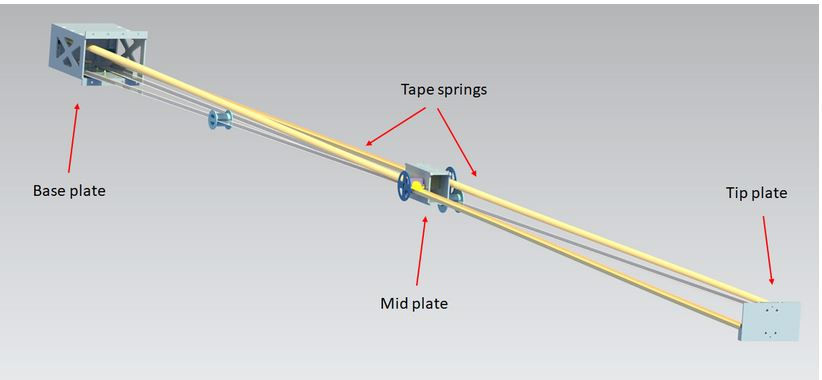How does the Boom Bloom?
- B2D2

- Apr 27, 2020
- 2 min read
Hej hej everyone! Danai here, locked at home as most of you, so let us boggle our minds with interesting stuff. In this blog we will discuss the star of the show, as the name of our project suggests (B2D2 – Bi-Stable Boom dynamic deployment), the Boom.

Before deployment, the boom box sits inside the Free Falling Unit (FFU), in a stowed position as we saw in ‘The nuts and bolts of B2D2’. At T +130 seconds and at approximately 80km altitude, the string holding the boom lid closed is cut and the boom is deployed. Now let’s see how this magic happens.

The boom in its deployed form is two meters long, the base plate of the boom is fixed on the FFU by the two flanges extending from the box, connected to that is the mid plate, that has one of the two SMILE magnetometers that we use for the measurements of the earth’s magnetic field and finally connected to that, is the tip plate, which holds the second magnetometer. The three plates are connected by the tape springs, which serve a dual purpose, to provide structural support and serve as a release mechanism.
The tape springs are called bi-stable, the reason they’re called that, is because they have two stable states, coiled and uncoiled. In a coiled state, they have stored energy that they want to release, and if they are in between stable states, they have the tendency to reach the lower energy state, which is uncoiled. Taking advantage of that trait, we use the tape springs as a release mechanism, by attaching one end of the tape spring on each plate, so when they start uncoiling, they will move the plates away from each other.
The tape springs that connect the boom sections are four, two on each side. Each tape spring pair is attached to a spool free to rotate on the mid plate. At the moment of release, these four tape springs simultaneously begin to uncoil. To help the tape springs uncoil, there are two leaf springs on the back plate and two on the tip plate that push against the mid plate.


The reason the boom must be that long, is because we want to put a distance between the magnetometers and the rest of the structure and its electronics, so they won’t interfere.
Finally, after deployment, which hopefully will accomplish our first goal, to demonstrate the deployment of a bi-stable composite boom, comes the second goal, to gather high quality measurements of the earth’s magnetic field, by using the two SMILE magnetometers. The sensors, one on the mid plate and one on the tip plate will gather information, and through two flat cables, the data will be transferred back to the FFU.
That’s all folks from me, take care and make sure to check out our website: www.b2d2.se, our Facebook page, and our Instagram accounts. Next stop on the B2D2 train: Tape Springs!
T-11 Months






Comments